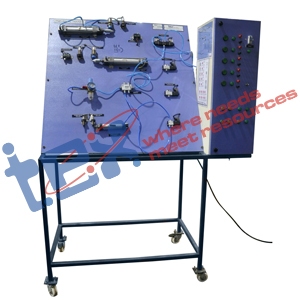

The Pneumatic Trainer is a comprehensive educational setup designed to demonstrate the principles, operation, and applications of pneumatic systems used in industrial automation. This training equipment allows learners to study the fundamentals of compressed air control, actuator operation, and valve sequencing in real-world pneumatic circuits.
Highly suitable for Engineering Colleges, ITIs, Polytechnics, and Technical Training Institutes, this pneumatic lab equipment provides a practical learning platform for understanding the working of industrial pneumatic components and system integration.
The Pneumatic Trainer is equipped with essential industrial components such as compressors, air preparation units (FRL), directional control valves, actuators (cylinders), pressure gauges, and tubing. It allows students to design, assemble, and test different pneumatic control circuits safely and efficiently.
This pneumatic educational setup provides hands-on training in the principles of air power control, sequencing, and automation. Learners can perform experiments related to single-acting and double-acting cylinders, pressure control, flow regulation, and timing circuits.
Mounted on a sturdy, powder-coated frame, the trainer ensures long life and consistent performance in laboratory conditions. The modular layout enables quick connection and reconfiguration of components, making it ideal for repeated experimentation and classroom demonstrations.
| Specification | Details |
|---|---|
| Power Supply | 230V AC, 50Hz |
| Air Supply | 4–6 bar regulated compressed air |
| Valves | Directional, flow control, and pressure control valves |
| Actuators | Single and double-acting pneumatic cylinders |
| Air Preparation Unit | FRL (Filter, Regulator, Lubricator) with gauge |
| Circuit Connections | Flexible polyurethane tubing and quick couplers |
| Measuring Instruments | Pressure gauges, flow indicators |
| Construction | MS powder-coated frame with component mounting board |
| Safety Features | Pressure relief valve, overload and leak protection |
The Pneumatic Trainer Kit bridges the gap between theoretical knowledge and practical understanding of pneumatic control systems. Students gain hands-on experience in designing and analyzing pneumatic circuits commonly used in automation and manufacturing industries.
By performing experiments, learners can understand the functioning of actuators, valves, and control elements while developing essential troubleshooting and circuit design skills.
Ideal for Engineering Colleges, ITIs, and Polytechnic Institutes, this trainer enhances student proficiency in process automation, mechanical engineering, and fluid power technology, making it an indispensable tool for modern technical education.